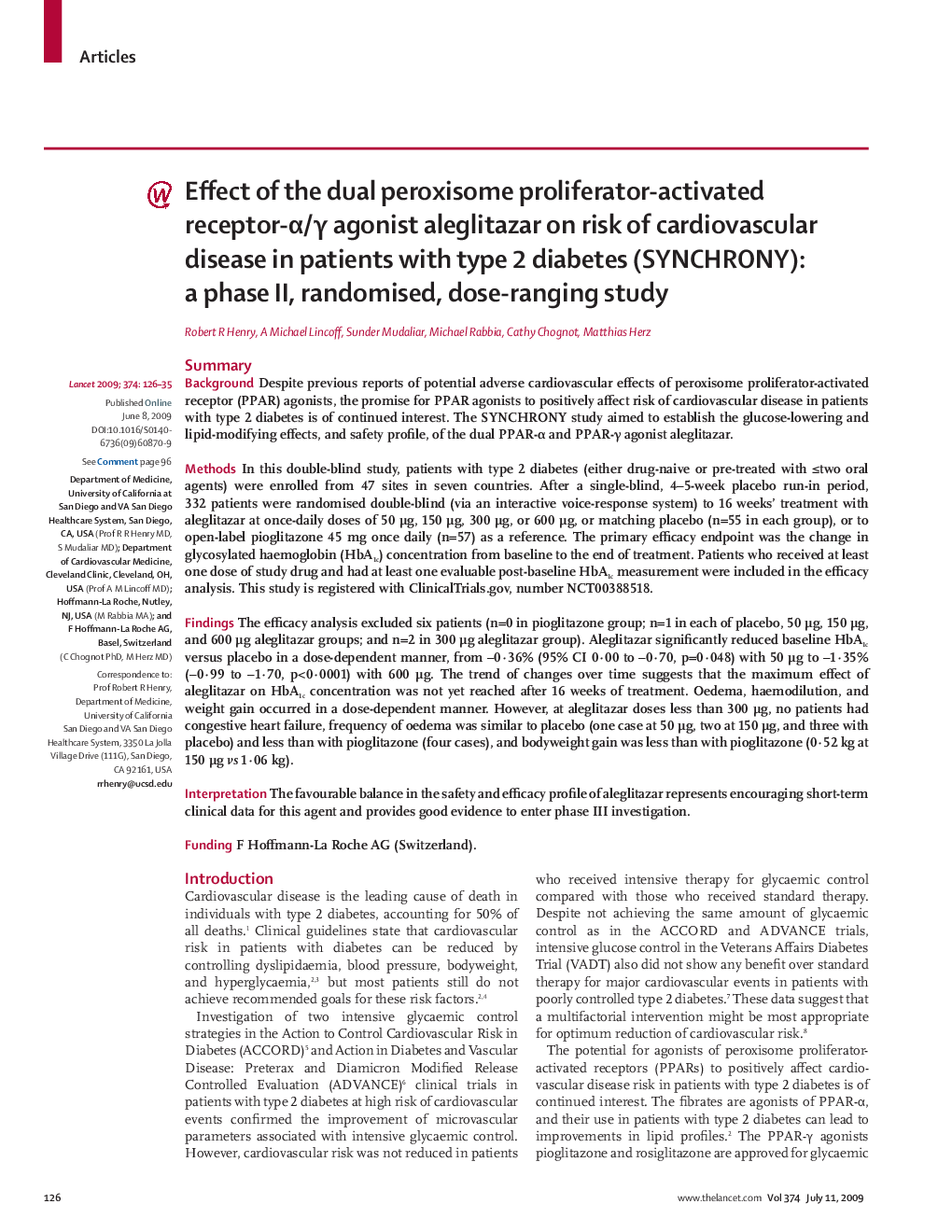| کد مقاله | کد نشریه | سال انتشار | مقاله انگلیسی | نسخه تمام متن |
|---|---|---|---|---|
| 3494612 | 1234308 | 2009 | 10 صفحه PDF | دانلود رایگان |

SummaryBackgroundDespite previous reports of potential adverse cardiovascular effects of peroxisome proliferator-activated receptor (PPAR) agonists, the promise for PPAR agonists to positively affect risk of cardiovascular disease in patients with type 2 diabetes is of continued interest. The SYNCHRONY study aimed to establish the glucose-lowering and lipid-modifying effects, and safety profile, of the dual PPAR-α and PPAR-γ agonist aleglitazar.MethodsIn this double-blind study, patients with type 2 diabetes (either drug-naive or pre-treated with ≤two oral agents) were enrolled from 47 sites in seven countries. After a single-blind, 4–5-week placebo run-in period, 332 patients were randomised double-blind (via an interactive voice-response system) to 16 weeks' treatment with aleglitazar at once-daily doses of 50 μg, 150 μg, 300 μg, or 600 μg, or matching placebo (n=55 in each group), or to open-label pioglitazone 45 mg once daily (n=57) as a reference. The primary efficacy endpoint was the change in glycosylated haemoglobin (HbA1c) concentration from baseline to the end of treatment. Patients who received at least one dose of study drug and had at least one evaluable post-baseline HbA1c measurement were included in the efficacy analysis. This study is registered with ClinicalTrials.gov, number NCT00388518.FindingsThe efficacy analysis excluded six patients (n=0 in pioglitazone group; n=1 in each of placebo, 50 μg, 150 μg, and 600 μg aleglitazar groups; and n=2 in 300 μg aleglitazar group). Aleglitazar significantly reduced baseline HbA1c versus placebo in a dose-dependent manner, from −0·36% (95% CI 0·00 to −0·70, p=0·048) with 50 μg to −1·35% (−0·99 to −1·70, p<0·0001) with 600 μg. The trend of changes over time suggests that the maximum effect of aleglitazar on HbA1c concentration was not yet reached after 16 weeks of treatment. Oedema, haemodilution, and weight gain occurred in a dose-dependent manner. However, at aleglitazar doses less than 300 μg, no patients had congestive heart failure, frequency of oedema was similar to placebo (one case at 50 μg, two at 150 μg, and three with placebo) and less than with pioglitazone (four cases), and bodyweight gain was less than with pioglitazone (0·52 kg at 150 μg vs 1·06 kg).InterpretationThe favourable balance in the safety and efficacy profile of aleglitazar represents encouraging short-term clinical data for this agent and provides good evidence to enter phase III investigation.FundingF Hoffmann-La Roche AG (Switzerland).
Journal: - Volume 374, Issue 9684, 11–17 July 2009, Pages 126–135